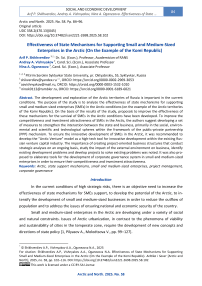Effectiveness of State Mechanisms for Supporting Small and Medium-Sized Enterprises in the Arctic (On the Example of the Komi Republic)
Автор: Shikhverdiev A.P., Vishnyakov A.A., Oganezova N.A.
Журнал: Arctic and North @arctic-and-north
Рубрика: Social and economic development
Статья в выпуске: 58, 2025 года.
Бесплатный доступ
The development and exploration of the Arctic territories of Russia is important in the current conditions. The purpose of the study is to analyze the effectiveness of state mechanisms for supporting small and medium-sized enterprises (SMEs) in the Arctic conditions (on the example of the Arctic territories of the Komi Republic). On the basis of the results of the study, proposals to improve the effectiveness of these mechanisms for the survival of SMEs in the Arctic conditions have been developed. To improve the competitiveness and investment attractiveness of SMEs in the Arctic, the authors suggest developing a set of measures to strengthen the interaction between the state and business, primarily in the social, environmental and scientific and technological spheres within the framework of the public-private partnership (PPP) mechanism. To ensure the innovative development of SMEs in the Arctic, it was recommended to develop the “Arctic Venture” model as a high-tech tool for innovative development within the existing Russian venture capital industry. The importance of creating project-oriented business structures that conduct strategic analyses on an ongoing basis, study the impact of the external environment on business, identify existing development problems and develop projects to solve existing problems was noted. It was also proposed to elaborate tools for the development of corporate governance system in small and medium-sized enterprises in order to ensure their competitiveness and investment attractiveness.
Arctic, state support mechanisms, small and medium-sized enterprises, project management, corporate governance
Короткий адрес: https://sciup.org/148330878
IDR: 148330878 | УДК: 338.2(470.13)(045) | DOI: 10.37482/issn2221-2698.2025.58.102
Текст научной статьи Effectiveness of State Mechanisms for Supporting Small and Medium-Sized Enterprises in the Arctic (On the Example of the Komi Republic)
DOI:
In the current conditions of high strategic risks, there is an objective need to increase the effectiveness of state mechanisms for SMEs support, to develop the potential of the Arctic, to intensify the development of small and medium-sized businesses in order to reduce the outflow of population and to address the issues of ensuring national and economic security of the country.
Small and medium-sized enterprises in the Arctic are developing under a variety of social and natural constraints. Issues of Arctic urbanization, in contrast to the phenomena of viability and sustainability of cities in the temperate zone, require the development of new concepts and directions of state policy [1, Pilyasov A., Molodtsova V., pp. 99–127].
Natural constraints have both negative and positive impacts on the regional economy [2, Tol R.S.J., pp. 29–51], including in the field of energy [3, M. de Witt, H. Stefansson, A. Valfells et al., pp. 144–156]. However, SMEs have already made a significant contribution to the creation of new jobs and increased the dynamism, flexibility and innovativeness of the Russian Arctic economy.
There is a lack of effective tools to ensure the survival and development of SMEs in the Arctic conditions, the use of the Arctic potential for the growth of gross domestic product and ensuring economic security in general.
The presence of competitive enterprises in the Arctic requires both reasonable protectionist support measures from the state and the provision of Arctic SMEs with opportunities to establish partnerships with large enterprises and integrate into their sphere of activity. A consistent state policy is needed to ensure effective interaction and mutual benefit between large and small enterprises in the Arctic.
At the present stage, the socio-economic development of the country is carried out by deepening regional disparities in the standard of living of the population and socio-economic development of individual subjects of the Russian Federation, which negatively affects the formation and development of SMEs, including in the Arctic [4, Dmitrieva T., Buriy O., p. 86–99].
At the same time, the given development vector is interdependent with the priority of the innovative socially-oriented scenario; in this regard, the urgent task is to provide special support to the entrepreneurial ecosystem. SMEs are recognized as determinants of economic growth and social stability in general.
In order to analyze the objective necessity of SMEs development in the Arctic, we will cite the opinion of the President of the Russian Federation V.V. Putin, who noted that since large-scale investment projects are being actively developed in the Russian Arctic, the key task, along with large industrial, energy and other projects, is to lay the foundations for the development of the service economy in cities, to form the basis for strong small and medium-sized businesses in order to solve the problems that arose in the past and have not yet been comprehensively resolved, the problems of single-industry towns 1.
In China, one of the fastest growing economies in the world and the second largest in terms of GDP, SMEs account for 60% of the economy, 79% of jobs are created exclusively by SMEs, and the tax share of SMEs in the national budget exceeds 2.
In 2018, in his speech on the state of affairs in the country and the main directions of domestic and foreign policy, the President of the Russian Federation noted the importance of developing small and medium-sized enterprises as a major reserve for economic growth 3. According to the President, by 2024, the contribution of SMEs to GDP will approach 40%, and the number of jobs created at these enterprises will amount to 19-25 million.
However, today even in the regulatory documents on the development of small and medium-sized businesses there is no key indicator — the share of SMEs in the gross domestic product. An increase in the number of people employed in small and medium-sized enterprises is accepted as a significant indicator. In accordance with the theory of expanded reproduction, it remains unclear why and how it is possible to increase the number of employees of enterprises, if there is no growth in the output of the final product. Therefore, it is objectively necessary to accept the increase in the share of small and medium-sized businesses in the country’s GDP as a key indicator of SMEs development at the state level, which will lead to real activation and increased responsibility of institutions for the development of entrepreneurship, including government agencies, and will make the prospects and final results of the SMEs development clear and transparent.
Literature review and research materials
Currently, there is a need to continue research on entrepreneurial and Arctic topics using scientific tools, identifying patterns with the help of modern information technologies in the field of modelling economic processes and building entrepreneurial ecosystems in the Arctic.
A number of regulatory documents on the development of the Arctic have been adopted in Russia. The most important of them are: The Strategy for Developing the Russian Arctic Zone and Ensuring National Security until 2035 4, The Main Directions of the State Policy of the Russian Federation in the Arctic until 2035 5.
The State program for the Socio-Economic Development of the Arctic Zone of the Russian Federation 6 assumes intensification of the development of the Arctic territories of Russia by creating new jobs with extra-budgetary investments and increasing international recognition through the organization of international events. The priorities and goals of state policy in the field of implementing the State Plan are related to the development of the socio-economic potential of the Arctic zone of the Russian Federation and improving the quality of life of its residents.
Taking into account the importance of the role of the state in the development of entrepreneurship in the Arctic, the basic Federal Law “On State Support of Entrepreneurial Activity in the Arctic of the Russian Federation” was adopted, which defines the legal system of the Arctic, the methods of state support and the procedure for implementing entrepreneurial activity 7.
It is important that the Government of the Russian Federation approved 8 a list of support settlements (municipalities) of the Arctic territories of the Russian Federation, including those performing the functions of ensuring national security and (or) bases for the development of mineral resource centers, economic facilities and (or) infrastructure in the Arctic zone of the Russian Federation.
Russian and foreign scientists are engaged in the issues of entrepreneurship development in the Arctic. Thus, A.N. Pilyasov made a significant contribution to the study and analysis of entrepreneurship in the Arctic [5]. He gives a definition of entrepreneurship in the Arctic, which includes, in addition to other categories inherent to entrepreneurship, the characteristics associated with the development of business in polar regions under certain restrictions caused by climatic and natural conditions. In his monograph [5], A.N. Pilyasov characterizes entrepreneurs in the sphere of business and services and nomadic entrepreneurs typical for the Arctic.
The specifics of SME development are described by such scientists as T.P. Skufina, E.A. Ba-zhutova and V.P. Samarina [6, pp. 51–68], who examine entrepreneurial activity in the regions of the Russian Arctic and compare it with the situation in Russia as a whole. They emphasize that the development of such entities as business and the state in the Arctic depends on regional features.
The peculiarities of entrepreneurship development in the Arctic are considered by such researchers as D.A. Vladimirskaya, M.V. Kutepova and V.A. Plotnikov [7, pp. 16–23]. They note that entrepreneurship in the Arctic macro-region has a number of important differences that should be taken into account in its regulation. The methodological basis for regulating entrepreneurship in the Arctic zone of the Russian Federation should be a program-targeted approach [7, pp. 16–23].
Taking into account the social significance of entrepreneurship in the Arctic, the issue of distributing social functions between the state and enterprises becomes important [8, Ivanova
M.V., Yakusheva U.E., pp. 56–69]. At the present stage, socially oriented non-profit organizations operating in the northern territories are becoming increasingly important [9, Novoselova I.Yu., Novoselov A.L., pp. 62–70]. Small and medium-sized enterprises are the main source of food for most Arctic regions and could help solve the problem of the food balance of the Arctic population. For example, A.V. Fedotovskikh considers small enterprises to be a driving force for the development of the Arctic [10, pp. 3–8]. The authors of this article fully share this position.
Of particular interest are the functional directions of the Arctic Institute of Entrepreneurship in various areas, including legal regulation [11, Zhura S.E., Ershova I.V., Goltsov V.B., pp. 78– 84].
The results of studies of factors of entrepreneurship development in the Arctic region as a whole and in the Arctic zone of the Komi Republic are published in the monograph “Entrepreneurial Ecosystems: Problems and Opportunities” [12, Shikhverdiev A.P., Vishnyakov A.A., Chemashkin A.Yu. et al.]. One of the main conclusions of the study is that the state is the main driver of the entrepreneurial ecosystem in the Arctic, ensuring its effective regulation and support [13, Shikverdi-ev A.P., Vishnyakov A.A., Oganezova N.A. et al., pp. 34–58].
Study of the main factors of the effectiveness of government structures in supporting SMEs in the Arctic (on the example of the Komi Republic)
The Research Center of Corporate Law, Management and Venture Investment of the Piti-rim Sorokin Syktyvkar State University conducted a study on the efficiency of Arctic entrepreneurship and building entrepreneurial ecosystems in 2022–2023. The study analyzed the mechanisms of state support for SMEs, public-private partnership development mechanisms, personnel and enterprise management, SME information support systems, financial support for SMEs, and opportunities for innovative SMEs development.
The study conducted by the authors revealed the following negative components of SMEs development in the Arctic (see Fig. 1).
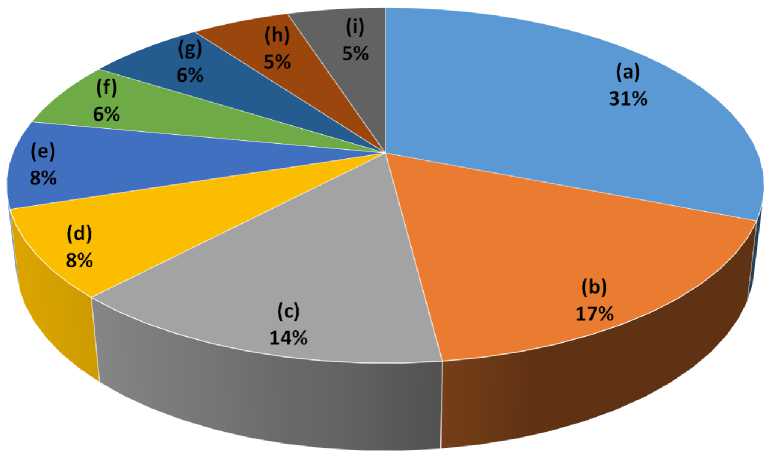
Fig. 1. Negative components of SMEs development in the Arctic: (a) — financial, (b) — high taxes, (c) — imperfect legislation, (d) — insufficient level of qualification of employees, (e) — technical and technological, (f) — ineffective management, (g) — remoteness, expensive logistics, (h) — informational, (i) — administrative barriers 9.
A significant number of study participants (31%) believe that one of the main problems of SME development is the financial component.
The development of SMEs is negatively affected by the problems of insufficient efficiency of the state regulation and support system for SMEs, in particular: taxation, legislative and administrative regulation (in total — 36% of participants).
Problems associated with the ineffective management system and low level of qualification of personnel, identified in total by 14% of participants, are also of great importance.
In this regard, there is an urgent need to improve the level of enterprise management and address the issue of increasing the professionalism of personnel. This requires risk management mechanisms, high-tech financial mechanisms, a large-scale securities market, project management methodology, organizational culture and a system of corporate and social responsibility, as well as an infrastructure for responding to changes in the external environment.
Source: prepared by the authors.
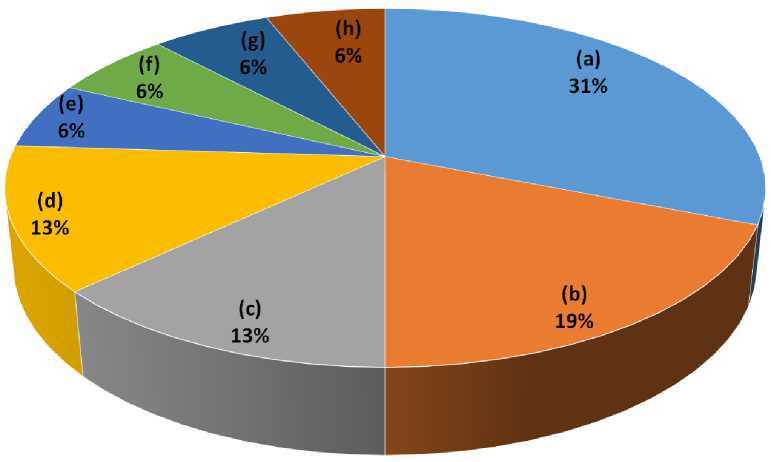
The analysis shows that 31% of respondents do not use state support mechanisms at all, which is a cause for serious concern (see Fig. 2). There are two possible explanations for this. One of them is that these schemes are inefficient and therefore not widespread; the other is the lack of information about existing mechanisms and schemes from the state for small and medium-sized businesses. It is advisable to increase the efficiency of all institutions for the development of entrepreneurship in the system of state support for SMEs.
At the same time, popular schemes of state support for SMEs are subsidies (19%), preferential loans and leasing schemes (13% each).
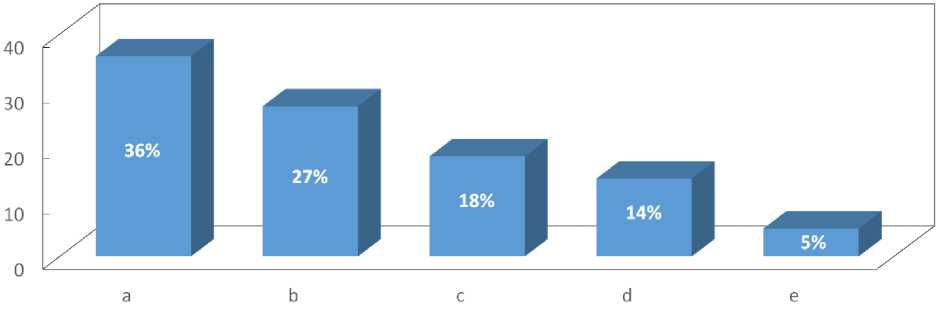
Fig. 3. Forms of interaction between enterprises and the government to improve the competitiveness of SMEs: (a) — information and legal consulting centers at regional and local government bodies, (b) — joint programs for retraining and advanced training of personnel, (c) — conferences, scientific and practical seminars, round tables, (d) — publicprivate partnerships, (e) — publication of reference, information and analytical materials 11.
-
10 Source: prepared by the authors.
-
11 Source: prepared by the authors.
The respondents named consulting and information and legal cooperation (36%), training and retraining of personnel familiar with the Arctic specifics (27%) as the most convenient forms of interaction between business and government (see Fig. 3), which indicates the need to provide information and personnel support to SMEs. This suggests a need to improve the effectiveness of business development agencies and chambers of commerce and industry. It should also be noted that some respondents pointed to the insufficient development of such institutions as partnership between the state and business.
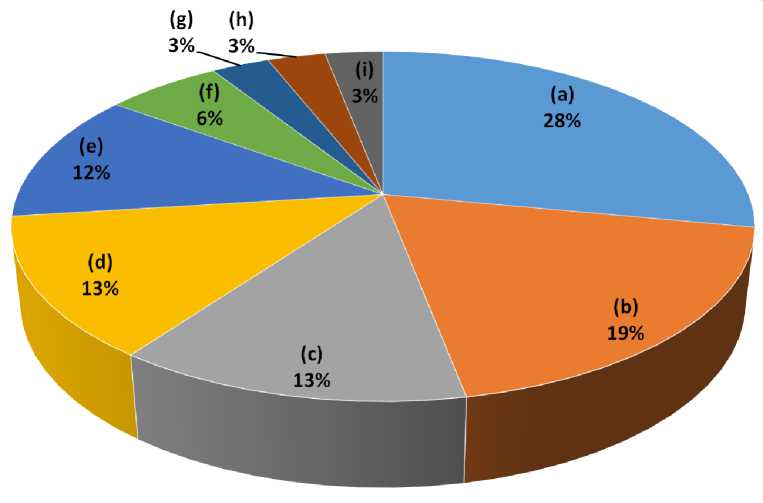
Fig. 4. External negative factors affecting the development of SMEs: (a) — high cost of loans, (b) — constantly changing “rules of the game” and poor information from the authorities, (c) — insufficient level of qualification of personnel in the labor market, (d) — high taxes, (e) — limited access to other sources of financing, (f) — other, (g) — annual increase in prices for sold products (imported), (h) — decrease in purchasing power of the population over several years, (i) — expensive rent 12.
More than 50% of negative external factors (see Fig. 4) hindering the development of enterprises are: high cost of loans (28%), high taxes (13%) and lack of alternative sources of financing (12%). This shows the need for serious changes in the sphere of financial support for Arctic entrepreneurship.
Frequently changing legislation and insufficient level of information transparency (19%), insufficient level of quality of labor force in the market (13%), weak connections between educational institutions and business structures, absence of effective alternative instruments of business financing and shortage of project-oriented SMEs impede development of entrepreneurship. These are very important external factors.
Source: prepared by the authors.

Fig. 5. Internal negative factors influencing the development of SMEs: (a) — other, (b) — insufficient level of modernization and greening of production, (c) — insufficient qualification of personnel, (d) — incomplete information about the situation in priority markets, (e) — absence of own innovative developments, (f) — ineffective interaction with authorities 13.
The participants identified the following as negative components of SMEs competitiveness: lack of information about the state of the external and internal market (19%), unpreparedness of personnel for environmental requirements in the Arctic, as well as a lack of knowledge about the specifics of enterprise management in the harsh Arctic climate (19%), and the absence of innovative activities (14%) (see Fig. 5). In this regard, chambers of commerce and industry and business development agencies should improve their work on the timely and complete provision of information, educational institutions and chambers of commerce and industry should strengthen their work on training personnel specifically for work in the Arctic and improve the implementation of innovative development programs at the national level to generate innovative developments.
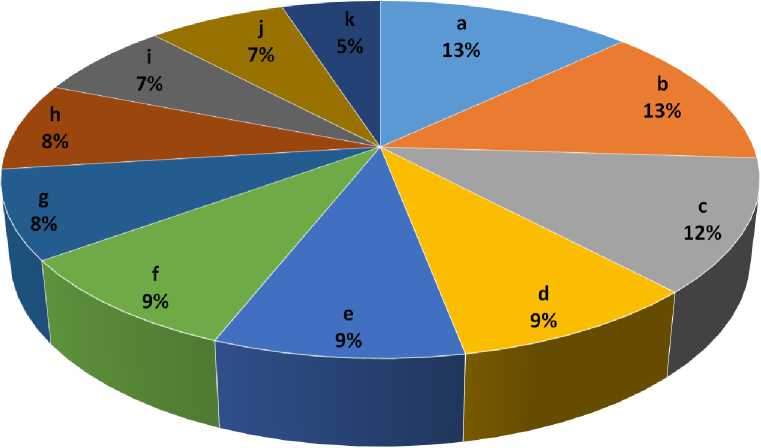
Fig. 6. The most popular instruments for SMEs development in the Arctic territories of the Komi Republic: (a) — preferential loans, (b) — regional tax incentives, (c) — subsidies, (d) — property support, (e) — grants, (f) — information support, (g) — educational programs (retraining, advanced training), (h) — assistance in placing government orders, (i) — consulting support, (j) — provision of guarantees for lending, (k) — activities of small business support funds 14.
Effective financial instruments for SMEs development in the Arctic are considered the most important by 50% of respondents. These include loans that do not require repayment, tax incen-
-
13 Source: prepared by the authors.
-
14 Source: prepared by the authors.
tives, budget transfers and significant grants for the creation and development of entrepreneurship.
Problems in this area require special state mechanisms for solution. An important role here is played by the creation of alternative instruments for SME financing, for example, through the establishment and development of an effective stock market by the state.
Conclusion
As a result of the conducted research, we have identified the following problems:
-
1. Low level of competitiveness and investment attractiveness of SMEs in the Arctic.
-
2. Lack of alternative and accessible financial sources as an important part of the mechanism for activating SMEs in the Arctic. It is objectively necessary to create an infrastructure of long-term investments for the development of entrepreneurship in the Arctic.
-
3. Lack of specialized financial resources for the innovative development of SMEs in the Arctic.
-
4. Risk that the relationship between Arctic residents and indigenous peoples are not fully regulated by law.
-
5. Difficulty in maintaining and preserving the existing business environment (non-resident business structures) as a source of development in the Arctic due to the insufficiency of legislatively established benefits for SMEs in the Arctic.
-
6. Lack of a clear and targeted system of quantitative and qualitative parameters of the economic state of the Arctic of the Russian Federation, which threatens regional and national economic security.
-
7. Insufficiently high level of corporate governance in small and medium-sized businesses.
-
8. Low level of information transparency of small and medium-sized businesses.
-
9. Insufficiently high level of professionalism of both managers and employees of small and medium-sized businesses.
Recommendations for eliminating the identified problems:
-
1. In order to increase the competitiveness and investment attractiveness of SMEs in the Arctic, it is required to develop a set of measures to strengthen the interaction between the state and business, primarily in the social, environmental, scientific and technological spheres within the framework of public-private partnership (PPP).
-
2. For the survival and development of SMEs in the Arctic, it is necessary to develop the stock market as a means of financing SMEs in the Arctic in order to facilitate the creation of an ecosystem of public-private partnerships and the transition from savings to investment.
-
3. It is necessary to develop incentives to ensure innovative development of SMEs in the Arctic. It is important to create opportunities for the development of SMEs through venture investments within the framework of the innovative scenario in the Arctic.
-
4. It is necessary to adopt a legislative act regulating issues of responsibility in relations between Arctic residents and indigenous peoples. The existing Liability Standard adopted by the Ministry of the Russian Federation for the Development of the Far East and the Arctic (Order No. 181 of November 23, 2020) is advisory in nature.
-
5. It is recommended to extend the benefits provided for Arctic residents in accordance with the federal law “On State Support for Entrepreneurial Activity in the Arctic of the Russian Federation” to all small and medium-sized businesses operating in the Arctic.
-
6. It is important to correlate the development of Arctic entrepreneurship with the issue of ensuring economic security in all key parameters, defining threshold values for threats to economic security and thus increasing the efficiency of economic decisions.
-
7. It is essential to ensure the interest of large enterprises in using the capabilities of SMEs. For these purposes, it is necessary to develop a set of measures to stimulate mutually beneficial cooperation between large enterprises and SMEs, the involvement of SMEs in the activities of large enterprises and models of such interaction.
-
8. It is important to create project-oriented business structures that conduct strategic analysis on an ongoing basis, analyze the impact of the external environment on business, identify existing development problems and develop projects to solve existing problems. In such business structures, the processes of accumulation, expansion and reproduction of capital, improving the quality and quantity of goods and services are more efficient, this is important in the Arctic conditions to ensure the sustainable development of the entrepreneurial spirit.
-
9. It is necessary to elaborate tools for the development of corporate governance system at small and medium-sized enterprises in order to ensure competitiveness and investment attractiveness. The main components of the required corporate governance system adapted for small and medium-sized enterprises are: information transparency of enterprise activities; efficiency and independence of the enterprise’s supervisory body (board of directors); availability of effective tools for preventing conflicts of interest; compliance with corporate procedures and a high level of corporate culture; trust in managers; efficiency of the internal control and risk management system; transparency of the company’s ownership structure; minimization and regulation of compliance risks and ensuring control over large and interested transactions; effective management and leadership of managers.
-
10. It is necessary to stimulate small and medium-sized enterprises to ensure a high level of information transparency, implemented through the enterprise’s information policy. This requires implementing a set of principles and tools that the enterprise is guided by to ensure information transparency of its activities. In order to achieve the goal of an effective information policy for
-
11. Taking into account the importance of human resources, especially in the Arctic, it is necessary to train management personnel to work in these specific conditions according to a special program. Managers in small and medium-sized businesses should be managerial leaders who possess the following essential qualities: the ability to quickly and correctly respond to changes in the external and internal environment; the ability to adapt to changes in the external environment in order to implement the company’s strategy; the ability to consider everything that happens as a system and be able to conduct a system analysis; the ability to prevent and regulate corporate conflicts; the ability to strategic planning; the use of modern methods of financial management; the ability to create an effective system of internal control and risk management.
It is proposed to develop the Arctic Venture model as a high-tech tool for innovative development within the existing Russian venture industry. It is important to stimulate development institutions and the Russian venture industry to develop the Arctic.
small and medium-sized enterprises, it is especially important to provide the company’s stakeholders with information on the structure and volume necessary for making effective decisions.
Conclusion:
In order to ensure sustainable development and economic stability in the Arctic, it is necessary to create conditions for the development of small and medium businesses. For this purpose, it is important to ensure the development of all components of the entrepreneurship ecosystem, and even more importantly, to do this on the basis of a systemic approach (interconnection and interdependence of all components of the ecosystem).
Our research has demonstrated that the quality of almost all factors of the entrepreneurial ecosystem in the Arctic depends on the effectiveness of government regulation. This includes such components as the PPP system, the internal control and risk management system, the stock market, the introduction of project management methodology, the financing and incentive system, security guarantees for enterprises so that small and medium businesses do not “freeze” in Arctic conditions.

